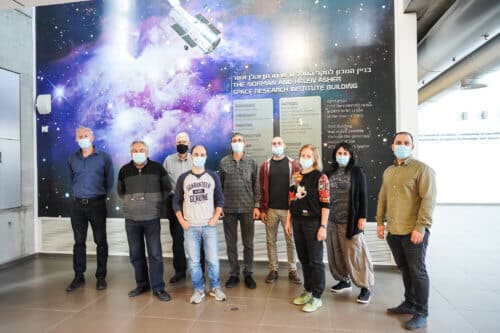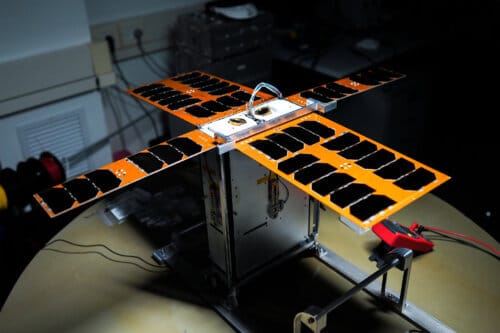"Adlis-Samson": an autonomous satellite fleet that will locate signals on Earth with high precision. This is the first launch of three Israeli satellites at the same time. The project was developed with the support of the Adelis Foundation, the Goldstein Foundation, the Israel Space Agency at the Ministry of Science and Technology and the Aerospace Industry

The "Adlis-Samson" project - an autonomous fleet of three nanosatellites - that was supposed to take off into space on March 20, but the launch was postponed for a day on March 22. After being developed and built at the Technion in recent years. The process was led by a team of researchers led by Prof. Finney Gurfil from the Asher Institute for Space Research at the Technion, a faculty member in the Faculty of Aeronautics and Space Engineering, with the support of the Adelis Foundation, the Goldstein Foundation and the Israel Space Agency at the Ministry of Science and Technology. The satellites will be launched on a Glavkosmos rocket from a launch site in Kazakhstan. The satellite fleet will be used to calculate the location of radiation sources on the surface of the earth, a technology that will be applied to locate people, planes and ships. The fleet of tiny satellites will move in space in an autonomous structure flight, that is, they will move in coordination with each other without the need for guidance from the ground.
The constellation includes three tiny satellites (CubeSats), each of which weighs about 8 kilograms. Measuring devices, antennas, computer systems, control systems, navigation devices and a unique and innovative propulsion system were installed on top of each satellite. The satellites will move in a formation flight at an altitude of 600 km above the ground and will locate, with high precision, signals on Earth. The signals will be transmitted to a special mission control center built at the Asher Institute for Space Research at the Technion. The mission receiver was developed in the aerospace industry. This is the first launch of three Israeli satellites at the same time.
Distributed space systems
"Many years of basic research, combined with advanced Israeli technology, allows us to take Israel an important step forward in the field of tiny satellites," he explains Prof. Pini Gurfil from the Asher Space Research Institute, Head The Laboratory for Distributed Space Systems at the Faculty of Aeronautics and Space Engineering. "You can compare the degree of innovation of nanosatellites to the transition from a computer to a cell phone. The 'Adelis-Samson' project demonstrates a new concept in nanosatellites and it will make it possible to carry out many operations that were until now reserved for large and expensive satellites. This is a leap forward in the capabilities of the Technion and the State of Israel as a whole in the field of small satellites, and it will make the Technion a global pioneer in the fields of localization and communication, with diverse applications that include locating missing people, rescue and rescue, remote sensing and environmental monitoring."
"The Edlis-Samson project is a wonderful and exciting example of a successful combination of science and technology and the translation of innovative ideas into effective systems that contribute to humanity," he said Technion President Prof. Uri Sion. "Scientific and technological breakthroughs today require multidisciplinary research and close cooperation between academia and industry, and these are the elements that led the project to this important day.

The previous satellite operated for 11 years in space
"The current launch continues a Technion tradition that began in 1998 with the successful launch of the Gorwin-Texat 2 satellite," added the Technion president. "This satellite operated in space for more than 11 years, a record time for academic activity in space. The launch of 'Adlis-Samson' is a dramatic moment that we have waited nine years for and will follow closely. I sincerely thank our partners at the Adelis Foundation, the Goldstein Foundation, the Israel Space Agency and the Aerospace Industry who helped us make this project a reality."
"For many years there has been a widespread belief that space technologies, and space itself, are the property of leading economic powers; which are complicated, large and expensive goals beyond the capabilities of ordinary countries," she said Rebecca Buchris, Adelis Foundation Trustee. "Israel refuted this, and today there is no disputing that the small country is a member of the limited circle of space powers, thanks to the rapid development of the space industry in Israel. 'Adlis-Samson' is a unique project that embodies the Israeli spirit, its strength and the intellectual resources of the State of Israel. It expresses its technological and scientific strengths and places it on the world map in the fields of aviation and space, all with a modest budget and in an academic environment. The Edlis Foundation sees itself as a body that sows the seeds of the future and hopes that this project will be the first of many. We hope that the 'Adelis-Samson' project will inspire other small and smart projects that will lead Israeli developments into space for the glory of the State of Israel."
"The field of nanosatellites is experiencing a significant boom in recent years and the number of launches is increasing every year," says Director of the Israel Space Agency at the Ministry of Science and Technology Avi Blasberger. "The costs of developing and launching such satellites, which are able to fulfill a variety of uses, are significantly lower than those of ordinary satellites. In the near future, networks are expected to appear that will include thousands of nano-satellites that will cover the earth and allow fast internet communication at a significantly lower cost than is common today, as well as many other applications such as the one that will be demonstrated by the Samson satellites."
"We see great importance in the cooperation with the Technion in order to promote academic research and future technologies in the field of space," said CEO of the Aerospace Industry Boaz Levy. "The Aerospace Industry, Israel's home of space, is the center of gravity in the field and sees the connection to academia as an added value at the business level and at the technological level that will lead to continued innovation and Israel's leadership in the field of space. The joint work leads to the continued development of the entire ecosystem and IAI is proud to join forces in this innovative and groundbreaking project."
All the unique developments of the satellites are blue-white products and were developed in an extraordinary collaboration between academia and industry: a special propulsion system, based on krypton gas, will be the first of its kind in the world to be operated on a tiny satellite. The digital receiver and the guidance control system was developed by the Aerospace Industry in collaboration with Technion researchers. In addition to the propulsion system, the satellites will accumulate energy through solar panels that will be deployed on the sides of each satellite and will be used as wings that, if necessary, control the flight of the structure without the use of fuel, through the air resistance in the atmosphere. A digital receiver was assembled on top of each of the nanosatellites, one of the most complex receivers ever designed in a nanosatellite. The system for processing the information on the satellite and the algorithms that will maintain the structure's flight will be among the first of their kind in the world, and will support the autonomous operation of several satellites at the same time. The navigation system will include two GPS receivers that will be used for autonomous navigation. The communication systems through which the three nanosatellites will communicate with each other and with the ground station will be operated on three different frequencies - a significant challenge solved in the current project. A dedicated frequency will be used to transmit information to the earth in broadband.
The Technion's 'Adelis-Samson' project involves many entities, including the Adelis Foundation, the Goldstein Foundation, the Israel Space Agency at the Ministry of Science and Technology, and the Aerospace Industry, which developed the mission receiver for detecting and locating signals from the ground. At the Technion, Asher Space Research Institute researchers Avner Kider, Hovik Aglarian, Dr. Vladimir Balanov, Avitar Adlerman, Yaron Oz, Maxim Rubanovich, Margarita Shamis, Yulia Konievski, Tzachi Ezra and Dr. Alex Fried are involved in the project, and many students have participated in it over the years. .
The launch will take place on Saturday, 20.3/8, at 07:07 (Israel time). For broadcast starting at 15:XNUMX (Israel time):
https://www.youtube.com/watch?v=J1nfIV-4_e8
More of the topic in Hayadan:

6 תגובות
My father, at an altitude of 600 km (the target altitude of the satellites) still has remnants of an atmosphere. If you point the satellite so that its cross-sectional area in front of the atmosphere is larger, you can create more resistance, slow it down and lower its orbit. In this respect, the solar collectors are not used as wings that create lift, but as air dampers. I just don't understand how the orientation of the collectors towards the traffic (instead of towards the sun) does not sabotage their efficiency as energy providers, unless they have excess capacity and in all traffic planning all these factors are taken into account.
The Israeli satellites are part of a large launch and launches are carried out when the launch window of the main satellite allows it.
When you write about CubeSat satellites you should also write how many U they have. From the photos it seems that these are 6U satellites.
Prof. Pini Gurfil (first from the left) with the team of researchers from the Asher Space Research Institute who worked on the project: Dr. Vladimir Balanov, Avner Kidar, Dr. Alex Fried, Hovik Aglarian, Yaron Oz, Margarita Shamis, Yulia Konievski, and Tzachi Ezra. Photo: Nitzan Zohar, Technion Spokesperson
Why on Saturday? We have enough power to demand
I didn't understand the sentence: "as wings that, if necessary, control the flight of the structure without the use of fuel, by means of the air resistance in the atmosphere."
If we are talking about satellites that are in space, what is the connection to the atmosphere and the wings.